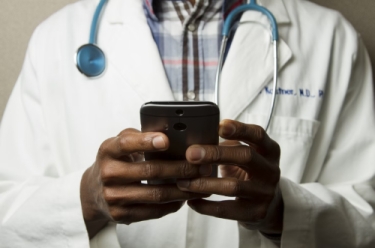The healthcare industry is set to undergo a pivotal time of change and evolution. Given below are eight technological meta-trends that are set to change the industry for the upcoming decade:
Artificial Intelligence
No surprises here. Artificial Intelligence (AI) has been the talk of the town for a while now, attracting both attention and investment. In fact, one in every four dollars invested in healthcare is going toward companies leveraging AI. Patient data has never been more abundant, and with AI models getting more sophisticated, expect more high-end uses than just writing an email to your boss on a lazy Monday morning. Spotting trends, providing personalized insights, and monitoring a live feed of data for anomalies and treatment reactions are just some of the many applications. Truth be told, the sky is the limit when it comes to potential use cases for AI in the healthcare space. Innovations like Zebra Medical Vision (medical imaging used to identifying conditions like fractures, lung diseases, and cancers with greater accuracy) and Tempus, ( AI driven precision medicine solution which enables doctors to analyze genetic data and tailor cancer treatments) are already setting the pace.
Blockchain
Cryptocurrencies may have tarnished the image of this technology, but write it off at your own peril. Its scope could be best explained with Estonia’s case study. In 2016 the nation’s tech-savvy government successfully transitioned from a paper-internet hybrid to a blockchain-based system for maintaining its public health records. Beyond the obvious benefits of improving data security and patient privacy, this approach has also had a positive impact on administrative efficiency as well as interoperability amongst different healthcare providers, which is a significant pain point of the industry. As the technology matures and has more such successful applications, expect it to go mainstream in the near future.
Nanotechnology
Nanotech devices may be minuscule, but their impact on healthcare will be colossal. Primarily, these devices can be very handy in diagnostic testing and drug delivery. Imagine using fabrics embedded with nanomaterials that can interact with the patient's body by regulating temperature and monitoring health or delivering drugs directly to specific cells or tissues. These are not the figments of sci-fi fantasy, but present-day reality and the use of nanoparticles in cancer therapy is just one example. Advancements in nanorobotics and precision manufacturing have the potential to fuel its advancement further, with applications going beyond patient data security into medical supply chain improvements and more.
Augmented Reality
Augmented Reality (AR) will be a game-changer for healthcare education. The level of detailing and adaptability will be unprecedented, with progress already being made. Interactive 3D anatomy models in the surrounding space will enable students to apply their learnings visually. Advanced AR headsets could also assist nurses in finding veins more easily and surgeons in the operating room. The increasing involvement of Big Tech companies like Meta and Apple in building consumer-centric AR products could also hasten developments in this field, making augmented reality more real.
3D Printing
The most mature tech on this list, 3D Printing, has already drastically changed hundreds of thousands of lives for the better across the globe. 3D printing can create implants and prosthetics as per the specific requirements of the patient. The ability to create organs and tissues with a special ink called “bio-ink” has been a massive enabler, allowing improvements to move beyond limbs. Also known as additive manufacturing, the industry is receiving a push from the White House. With renewed policy focus and government support, expect the off-shoots of this growth to have a positive impact on healthcare.
Remote Patient Monitoring
The COVID-19 pandemic has accelerated all things remote, with healthcare being at the forefront of this change. Healthcare professionals can expect more and more of their patients to prefer remote diagnostics and monitoring in 2024 and the future. Improved tech has played a central role here. Wearables have become cheaper and more accurate, and the Internet of Things (IoT) is becoming more mainstream. Niche health monitoring apps for a variety of edge cases are being built. Internet penetration and digital literacy are on the rise globally. All these factors combine to make a digital-first future ripe for disruption.
Surgical Robots

We’ve come a long way since the days of PUMA-560, the first robot ever used in surgery in 1985. Robotics is poised to enhance productivity and efficiency across different industries, and healthcare is no exception. Their use is not limited to surgery; they can also be used in rehabilitation, robotic lab automation, disinfection, elderly care, nursing and medicine dispensing. While its application and scope are immense, it is important to be cautious about its deployment in the near future as more work needs to be done to make these devices more nuanced and agile.
Cloud-Based Software
While its inclusion may come as a surprise, cloud-based software and solutions have been impacting healthcare for a while now. Healthtech startups with a slick interface and interoperability have been gathering momentum in the US. These have obvious advantages for professionals, like no hassle of maintaining expensive tech hardware and access to regularly updated software. With a greater share of health practitioners going digital, this trend is set to gain traction.
Over the next decade, as these technologies mature and enter public discourse, healthcare will undergo an inevitable evolution. It is imperative that industry stakeholders be prepared and start acquainting themselves by slowly meshing these into their workflow.










































